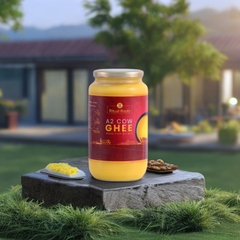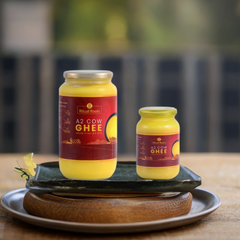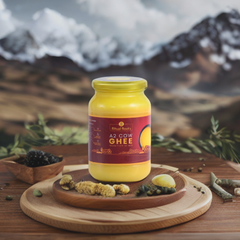
7 Simple Advice to Increase the Shelf Life of Cow Ghee
Cow ghee is a traditional and stable ingredient in every household. It has earned a special place in the kitchen and the hearts of skin-conscious individuals. Using cow ghee for skin provides a natural and delicate approach to achieving a healthy complexion. Known for its remarkable properties and numerous skin benefits, preserving the shelf life of this integral ingredient becomes crucial. Find out seven simple yet effective tips to ensure your cow ghee stays fresh and flavorful for an extended period.
-
Store in a Cool and Dark Place
The reason behind storing A2 cow ghee in a cool and dark place revolves around two primary concerns– heat and light. High temperatures speed up the oxidation in ghee. It results in a faster breakdown of nutrients and essential benefits. Sunlight contains ultraviolet rays that can catalyze the degradation of ghee.
Tip: Choose a designated cool and dark spot for your ghee container. Aim for a room temperature between 50°F and 70°F in this storage area. It helps maintain consistency and preserves the A2 cow ghee benefits for your health.
-
Use a Dry and Clean Spoon
A2 desi ghee is highly sensitive to contamination as the particles can affect its quality and taste. Moisture promotes bacterial growth, leading to spoilage and potentially harmful consequences. A dry and clean spoon handling A2 cow ghee offers several benefits.
Tip: Set aside a spoon exclusively used for your A2 cow ghee. It ensures that the ghee remains untainted by any residue from other foods. Additionally, consider rinsing the spoon with warm water and drying it before each use to guarantee a clean start.
-
Keep the Lid Closed Tightly
The presence of oxygen is one of the crucial factors why the taste and quality of ghee go bad. When ghee is exposed to air, cow ghee's flavor, taste, and nutritional value begin to erode. Additional moisture can lead to mold growth, affecting the quality and safety of the ghee.
Tip: If you've transferred your A2 cow ghee to a different container, ensure the container has a secure and well-fitted lid. This additional safety step ensures that your ghee remains shielded from external elements.
-
Avoid Double-Dipping
Each time a utensil, such as a spoon or a knife, is dipped into the ghee and then returned for a second serving, there is a risk of introducing external elements into the jar. It could include food particles, microbes, or even moisture, all of which can compromise the integrity of the A2 cow ghee.
Tip: Avoid reusing the same utensil without washing it, even if it seems convenient. This small but crucial step maintains the ghee's purity and prevents the introduction of foreign elements.
-
Use Airtight Containers
Airtight containers create a protective barrier to block the entry of air and moisture. Glass jars with tight-fitting lids, stainless steel containers with secure locks, or any plastic airtight container are excellent choices to secure the taste of your ghee.
Tip: Consider the transparency of the container as well. If your A2 cow ghee comes in a transparent jar, consider wrapping it in a dark material or storing it in a dark place to shield it from light exposure.
-
Regularly Check for Signs of Spoilage
It's essential to check ghee quality to treat any signs of spoilage routinely. Typical indicators are unpleasant odor, color change, or inappropriate texture. Keep an eye on it and replace it if these indicators are present.
Tip: If you notice any off-putting odors, discoloration, or an unusual texture, the ghee has expired. Promptly discard any ghee showing signs of spoilage to avoid adverse health effects.
-
Optimal Temperature Control
Extreme heat can cause it to become liquid, while very low temperatures can lead to solidification. Both scenarios can impact the texture and overall quality of the ghee. Temperature stability is crucial for preventing the separation of ghee's components, which could affect its taste and consistency. It ensures the ghee remains semi-solid, maintaining its smooth and velvety texture.
Tip: Choose a cool and dark place for the ghee jar. A pantry or cupboard where there is no contact with direct sunlight is the best-suited option for storage. Avoid storing near heat-related appliances such as stoves, ovens, or other kitchen appliances.
Elevate Your Ghee Experience with Ritual Roots
Savour the authentic taste of desi A2 cow ghee and elevate your experience with Ritual Roots. Utilize the most original and natural product for a healthy skin barrier. Cow ghee for the skin can improve its elasticity and enhance the skin's complexion. We understand the significance of providing pure ghee for your skincare needs. Our range is made with the traditional bilona method, ensuring you the authenticity and highest quality of products. Shop now and engage yourself in the tradition, goodness, and distinct taste that only Ritual Roots can deliver. Embrace the essence of pure A2 cow ghee in every delightful jar.
FAQ's
Q: Can I use ghee past its expiry date?
Expired ghee can pose health risks and other concerns. You should consume the product within six months for the best quality and taste.
Q: What is the ideal temperature for storing ghee?
A: The ideal temperature for storing ghee is between 50°F to 70°F. Keeping ghee within this temperature range helps maintain its benefits and prevents unpleasant changes in flavor and texture.
Q: Is storing ghee in a glass or plastic container safe?
A glass or plastic airtight container is ideal for storing ghee longer. These containers are made from food-grade materials to ensure the purity of ghee is reserved.
Q: What are some other uses for ghee besides cooking?
A: Besides being a flavorful cooking medium, ghee has various other uses. It can be used as a moisturizer for dry skin, a conditioning treatment for hair, and even as a component in certain traditional medicinal practices.
-

A2 Cow Pure Ghee , Desi Gir Cow (1 KG)
Rs. 2,470.00 -

A2 Cow Pure Ghee , Desi Gir Cow (1.5 KG)
Rs. 3,700.00 -

A2 Cow Pure Ghee , Desi Gir Cow (500gm)
Rs. 1,350.00


